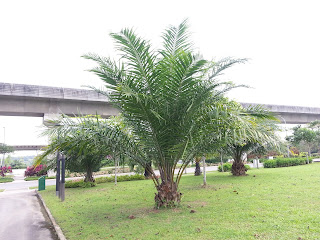Commonly known as the African Oil Palm, this palm is native to West Africa but cultivated throughout the tropics.
The Oil Palm, an introduced species, is a medium tolarge-sized palm with a single stem covered with old leaf scars and a crown of dense foliage. The moisture, which collects on the old leaf bases of the trunk, encourages the growth of epiphytic plants and ferns on the trunk.
The flowers are monoecious, whereby male and female flowers are in separate clusters, but on same tree.
Each fruit is plum-like, ovoid and oblong in shape about 3.5 cm long and about 2 cm wide. It is yellow to black and upon ripening, turns red at the base. The flesh is thick and ivory white, with a small cavity in the center. The nuts are encased in a fibrous covering which contains the oil. They are borne in bunches and each bunch weigh about 23kg on average. A bunch contains about 200 to 2000 sessile ovoid drupes.
Palm oil obtained for the Oil Palm is popular for use in cooking throughout the world, especially for its low price. Palm oil is used for manufacture of soaps and candles, and more recently, in manufacture of margarine and cooking fats. Palm oil used extensively in tin plate industry, protecting cleaned iron surfaces before the tin is applied. Oil also used as lubricant, in textile and rubber industries. Apart from the oil, the central shoot or cabbage is edible too. Leaves used for thatching; petioles and rachices for fencing and for protecting the tops of retid walls. Refuse after stripping the bunches used for mulching and manuring;, while the ash sometimes used in soap-making.


No comments:
Post a Comment